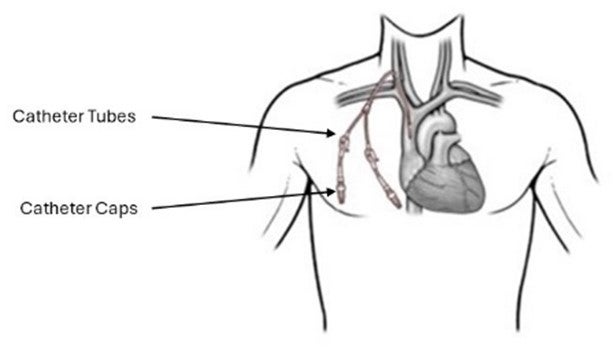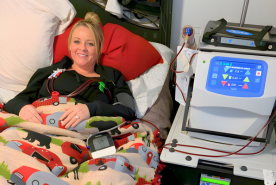Last updated: December 19, 2024
Medically reviewed by: NKF Patient Education Team
Catheter-related bloodstream Infection (CRBSI) can be serious. Causes, treatment and prevention are covered.
About CRBSI
Catheter-related bloodstream infection (CRBSI) is an illness where an infection (from germs such as bacteria or fungus) starts inside a catheter. A catheter is a type of hemodialysis access that is inserted into a large vein in the neck or chest. The infection can spread into the bloodstream and be very serious. It can cause sepsis, which is a severe harmful response to an infection.
Signs and Symptoms
A person with a CRBSI may notice drainage from the catheter exit site and redness or tenderness around the area. They may also feel nauseous and have a general feeling of weakness, fever and chills. A person with sepsis caused by a CRBSI may have any of the following symptoms:
- High heart rate or weak pulse
- Confusion or disorientation
- Extreme pain or discomfort
- High fever, shivering, or feeling very cold
- Vomiting
- Shortness of breath
- Clammy or sweaty skin
You or a loved one should seek medical attention for any infection, with urgent follow-up if the infection persists or worsens.
Causes
CRBSI is an infection that starts inside a catheter, which is a type of hemodialysis access that is inserted into a large vein in the neck or chest. The ends of the tubes sit on the skin outside the body. This type of access is generally used when you need to start dialysis immediately and/or for a short period of time (temporary access). However, catheters are used as a permanent access when a fistula or a graft cannot be placed. Catheters have a higher risk of bloodstream infection compared to fistulas and grafts. About 70% of dialysis related bloodstream infections happen in people with a catheter.
CRBSIs are usually caused by bacteria, a type of germ. Types of bacteria that can cause a CRBSI include staphylococcus, pseudomonas and enterococcus. Staphylococcus is the most common cause of CRBSI.
Fungal infections are also possible. Candida is a type of yeast or microscopic fungus that can cause CRBSI.
The bacteria or fungus causing infection can come from many places, including the natural bacteria that grows on your skin or floating in the air from people talking, breathing, or sneezing.
There are multiple risk factors that can raise the risk of a CRBSI. These include:
- Use of a catheter for a long period of time
- Improper care of the catheter/insertion site
- An underlying disease, such as diabetes
- History of a previous CRBSI
- Recent surgery or hospitalization
- Use of immunosuppressants (anti-rejection medicines)
- Malnutrition (not getting enough nutrients to maintain your health)
Complications
Complications of CRBSI include the following:
- Nerve injury
- Dangerous blood clot
- Irregular heartbeat (arrhythmia)
- Leaky blood vessels
- Low blood pressure (hypotension)
- Infection/Inflammation of the heart’s inner lining (endocarditis)
- Sepsis (which can lead to organ failure and hospitalization)
Diagnosis
A CRBSI is diagnosed following a medical assessment by a healthcare professional. The following tests may be done to gather more information:
- Blood tests to check for signs of infection or organ damage
- Blood and/or catheter tip culture to identify the germ causing the infection
- An X-ray or CT scan to find an infection or organ damage
A healthcare professional will look for signs and symptoms of a CRBSI. They will also rule out other causes of a bloodstream infection not related to your catheter. A CRBSI is usually confirmed with a blood culture, a lab test to check for bacteria or other germs in a blood sample. A culture sample from the catheter is tested.
With a blood culture, the sample is placed in a special dish called a culture dish. It is then observed to see if any disease-causing germs grow in the dish.
Treatment
If a CRBSI is severe and leads to sepsis, then treatment requires urgent medical care, usually in a hospital or intensive care unit (ICU). This allows for close monitoring of your vital signs and blood tests. Some people with severe illness may also need extra oxygen, a breathing tube, or a ventilator (breathing machine) to keep healthy oxygen levels.
In certain cases, the catheter may need to be removed. The decision to remove a catheter due to CRBSI can depend on several factors, such as the severity of the infection and the person’s condition and overall health.
Medicines
Antibiotics or antifungals should be started as soon as possible, usually given intravenously (IV), or directly into the vein. Antibiotics used to treat CRBSI include vancomycin, cefazolin, ceftazidime, or tobramycin. An antibiotic ointment can be used on the access site. If the CRBSI is caused by a fungus, an antifungal would be used (instead of an antibiotic), also given intravenously (IV). Antifungals for a CRBSI include fluconazole and micafungin.
Other IV medicines may also be needed to keep your blood pressure stable or prevent blood clots. You may also need medicines that keep blood sugars in target range, even if you do not have diabetes.
Prevention
Some general tips to reduce infection include:
- Take care of your overall health
- Avoid close contact with people who have active infections that can spread
- Keep any cuts, sores or other skin breaks clean and covered until they fully heal
Here are some tips for everyday care of your catheter to reduce risk of infection:
- Clean your vascular access site well before each session
- Be sure your catheter has a clean, dry dressing during and after every dialysis treatment
- Wash your hands before and after your dialysis session
- Wear a mask when connecting or disconnecting dialysis tubing
- Make sure dialysis staff check your catheter for signs of infection at every dialysis session
- Keep extra dressing supplies at home in case you need to replace your dressing
- Use a protective cover for your catheter to take a shower
- Make sure dialysis team members wash their hands, wear a mask, and use gloves when accessing your catheter
It’s important to take care of your health and your catheter.
Antimicrobial Caps and Catheter Locks
Infection control has gotten better over time, but CRBSI prevention remains a challenge. New ways to prevent CRBSI are being developed. Examples include antimicrobial caps and catheter locks.
Antimicrobial caps contain an antimicrobial agent (something that kills or stops the growth of germs), which is then placed on the catheter hub after use.
Catheter locks involve inserting a concentrated antimicrobial solution into your catheter tube to prevent infections. The solution stays in your catheter tube (outside your body) and is not meant to be ingested (inserted into your blood vessels or body). It is then removed before your next dialysis session. Antimicrobial catheter locks can contain an antibiotic, such as vancomycin, cefazolin or ciprofloxacin. Catheter locks that prevent infection without using antibiotics also exist. These products use agents like taurolidine, ethanol and citrate to prevent infection. One example of a lock that combines heparin with a germ-fighting agent (not an antibiotic), approved by the Food and Drug Administration for use in hemodialysis catheters, combines taurolidine and heparin.

Preparing for your appointment
Questions to ask
- Am I at risk for CRBSI (catheter-related bloodstream infection)?
- What can I do to lower my risk of CRBSI?
- How can I get a cover for my catheter when I take a shower? What other supplies do I need that I may not have?
- How long will I need to receive dialysis treatments through a catheter? Am I a candidate for another access method (like a graft or fistula)?
More resources
National Kidney Foundation
- Hemodialysis Access What you need to know - Stage 5
- Hemodialysis Catheters: How to Keep Yours Working Well
- Hemodialysis Access
- Catheter Related Blood Stream Infection (CRBSI)
Centers for Disease Control and Prevention (CDC)





